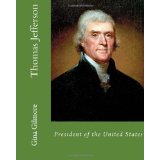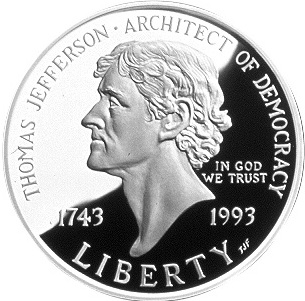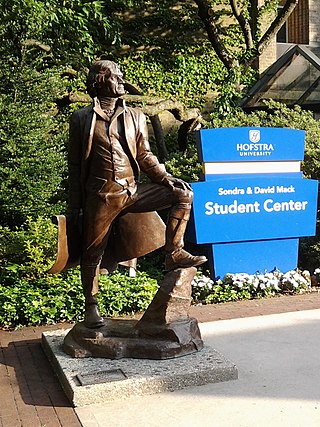
Thomas Jefferson was an American statesman, diplomat, lawyer, architect, philosopher, and Founding Father who served as the third president of the United States from 1801 to 1809. He was the primary author of the Declaration of Independence. Following the American Revolutionary War and prior to becoming president in 1801, Jefferson was the nation's first U.S. secretary of state under George Washington and then the nation's second vice president under John Adams. Jefferson was a leading proponent of democracy, republicanism, and individual rights, and produced formative documents and decisions at the state, national, and international levels. His writings and advocacy for human rights, including freedom of thought, speech, and religion, served as substantial inspirations to the American Revolution and subsequent Revolutionary War in which the Thirteen Colonies succeeded in breaking from British America and establishing the United States as a sovereign nation.

Monticello was the primary plantation of Thomas Jefferson, a Founding Father, author of the Declaration of Independence, and the third president of the United States, who began designing Monticello after inheriting land from his father at age 14. Located just outside Charlottesville, Virginia, in the Piedmont region, the plantation was originally 5,000 acres (20 km2), with Jefferson using the forced labor of Black slaves for extensive cultivation of tobacco and mixed crops, later shifting from tobacco cultivation to wheat in response to changing markets. Due to its architectural and historic significance, the property has been designated a National Historic Landmark. In 1987, Monticello and the nearby University of Virginia, also designed by Jefferson, were together designated a UNESCO World Heritage Site. The current nickel, a United States coin, features a depiction of Monticello on its reverse side.
Sarah "Sally" Hemings was a female slave with one-quarter African ancestry owned by president of the United States Thomas Jefferson, one of many he inherited from his father-in-law, John Wayles.

Thomas Jefferson University is a private research university in Philadelphia, Pennsylvania. Established in its earliest form in 1824, the university officially combined with Philadelphia University in 2017. The university is named for U.S. Founding Father and president Thomas Jefferson. It is classified among "R2: Doctoral Universities – High research activity".

The Life and Morals of Jesus of Nazareth, commonly referred to as the Jefferson Bible, is one of two religious works constructed by Thomas Jefferson. Jefferson compiled the manuscripts but never published them. The first, The Philosophy of Jesus of Nazareth, was completed in 1804, but no copies exist today. The second, The Life and Morals of Jesus of Nazareth, was completed in 1820 by cutting and pasting, with a razor and glue, numerous sections from the New Testament as extractions of the doctrine of Jesus. Jefferson's condensed composition excludes all miracles by Jesus and most mentions of the supernatural, including sections of the four gospels that contain the Resurrection and most other miracles, and passages that portray Jesus as divine.

Mount Jefferson is a mountain located on the Continental Divide between Fremont County of northeastern Idaho and Beaverhead County of southwestern Montana. Mount Jefferson is the highest point of the Centennial Mountains, whose crest runs along the Continental Divide and can be climbed using a class 2 route (scramble) from the access road to neighboring Sawtell Peak.

Thomas Theodore Jefferson is an American former sprinter. He won a bronze medal in the 200 m at the 1984 Summer Olympics. Jefferson also won a bronze medal in the 4×100 m relay at the 1984 Universiade and placed fourth in the 200 m at the 1991 World Indoors Championships. He was ranked #3 in the world over 200 m in 1984.
The Thomas Jefferson Center for the Protection of Free Expression was a nonprofit, nonpartisan institution devoted to the defense of the First Amendment rights guaranteeing freedom of speech and of the press. The center was founded in 1989, under the direction of former University of Virginia president Robert M. O'Neil. J. Joshua Wheeler succeeded O'Neil as Director of the Center in 2011. It is named after Founding Father and third president of the United States, Thomas Jefferson.
The "Taliaferro", "Robinson" or "Robertson" was a small-sized apple grown at Monticello by Thomas Jefferson. This cultivar appears to be extinct, though some horticulturalists assert that the 'Highland County' cultivar may be related, or even the same cultivar under a different name.

Memorandums taken on a journey from Paris into the southern parts of France and Northern Italy, in the year 1787, or Memoranda, is a text by Thomas Jefferson, written during a trip beginning February 28, 1787 from France to Italy.
Thomas Jefferson, the third president of the United States, owned more than 600 slaves during his adult life. Jefferson freed two slaves while he lived, and five others were freed after his death, including two of his children from his relationship with his slave Sally Hemings. His other two children with Hemings were allowed to escape without pursuit. After his death, the rest of the slaves were sold to pay off his estate's debts.
Dick the Mockingbird was the name of one of U.S. president Thomas Jefferson's pet birds. Although there had been previous presidential pets, Jefferson is thought to be "the first president to have a pet [that lived] in the White House..." Prior to his term in the Oval Office, Jefferson bought his first mockingbird in November 1772 from a slave of his father-in-law John Wayles for five shillings. Birds were Jefferson's favorite animal and Dick was the favorite from among at least four mockingbirds the president had while in office. During his time in the White House, Jefferson wrote observations on the types of birds that he spotted in the area. In May 1793, in response to a letter from his son-in-law Thomas Mann Randolph, Jefferson wrote: "I sincerely congratulate you on the arrival of the mockingbird. Teach all the children to venerate it as a superior being which will haunt them if any harm is done to itself or its eggs."

The 1804 United States presidential election in Pennsylvania took place as part of the 1804 United States presidential election. Voters chose 20 representatives, or electors to the Electoral College, who voted for President and Vice President.

The 1796 United States presidential election in Pennsylvania took place as part of the 1796 United States presidential election. Voters chose 15 representatives, or electors to the Electoral College, who voted for President and Vice President.
Jefferson's Garden is a 2015 play by Timberlake Wertenbaker. It premiered at the Watford Palace Theatre from 5 to 21 February 2015, with Jefferson played by William Hope. It begins in the 1750s, but is centred on the period from 1776 to the early 1790s, covering the American Revolutionary War and its aftermath. It is named after Thomas Jefferson's gardens at Monticello and contrasts his part in writing the American Declaration of Independence with the continuation of slavery in the American colonies and on Jefferson's lands after independence.

An outdoor sculpture of Thomas Jefferson by William Ordway Partridge is installed outside the School of Journalism on the Columbia University campus in Manhattan, New York, United States. It was modeled in plaster in 1901 and cast in bronze in 1914 by the New York–based foundry Roman Bronze Works.

The 1800 United States presidential election in New York took place between October 31 and December 3, 1800, as part of the 1800 United States presidential election. The state legislature chose 12 representatives, or electors to the Electoral College, who voted for President and Vice President.

The 1804 United States presidential election in New York took place between November 2 and December 5, 1804, as part of the 1804 United States presidential election. The state legislature chose 19 representatives, or electors to the Electoral College, who voted for President and Vice President.

The Thomas Jefferson 250th Anniversary silver dollar is a commemorative silver dollar issued by the United States Mint in 1994. The obverse portrays Founding Father and United States president Thomas Jefferson and the words "Architect of Democracy", and the reverse depicts Jefferson's Virginia home, Monticello.

A statue of Founding Father and United States president Thomas Jefferson is installed in Hempstead, New York. The memorial was relocated in June 2020 to the Hofstra University Museum.













